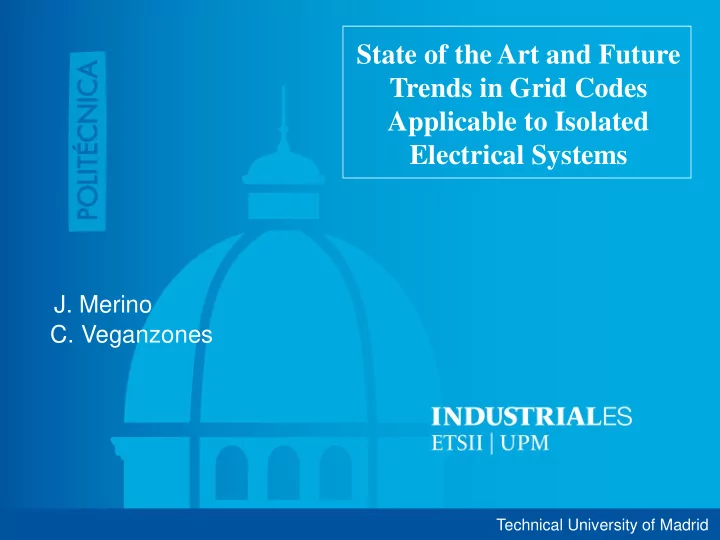

State of the Art and Future Trends in Grid Codes Applicable to Isolated Electrical Systems J. Merino C. Veganzones Technical University of Madrid
o Introduction o Characterization Of Voltage And Frequency Disturbances In Isolated Power Systems o Current Status of Isolated Power Systems o Overview of Grid Codes o Grid Codes in Isolated Systems o Future Trends in Isolated Grid Codes o Conclusions 1 J. Merino; C. Veganzones. Technical University of Madrid
INTRODUCTION (I) Main characteristics of isolated grids Found in remote Abundance of Radial networks Largely Lack or geographically renewable with few dependent on interconnection isolated locations energy sources generation nodes fossil fuels to the utility grid Need to develo lop speci cific fic grid codes es with stricter cter techni hnica cal requi uirem remen ents 2 J. Merino; C. Veganzones. Technical University of Madrid
INTRODUCTION (II) 1. Management of energy reserves Greater levels of energy reserves compared to interconnected systems and, sometimes insufficient 2. Fulfillment of security requirements 3. Estimation of foreseen generation and demand Difficulties to foresee Difficulties in forecasting incidents. High number of horizons in energy production violations of N-1 security from non-manageable criterion generation or demand 3 J. Merino; C. Veganzones. Technical University of Madrid
CHARACTERIZATION OF VOLTAGE AND FREQUENCY DISTURBANCES IN ISOLATED POWER SYSTEMS (I) o Voltage dip Nodes are physically close and connected through short distribution lines Important relative potency of the groups of generation load with respect to the total power Voltage dips in isolated systems are very deep and their area of propagation is very wide-spread. 4 J. Merino; C. Veganzones. Technical University of Madrid
CHARACTERIZATION OF VOLTAGE AND FREQUENCY DISTURBANCES IN ISOLATED POWER SYSTEMS (II) o Voltage swell/Overvoltage/Undervoltage Lines offer a great impedance that causes a high dependence on the degree of load voltage drop, which seriously affects the power quality in the point of common coupling (PCC) o Frequency oscillations Low inertia diesel generators can usually be found, which in the event of disturbance leads to frequency excursions greater than those that would occur in an interconnected system 5 J. Merino; C. Veganzones. Technical University of Madrid
CURRENT STATUS OF ISOLATED POWER SYSTEMS (I) Many of the systems that were isolated have been connecting progressively to other networks with similar characteristics or the Mainland due to the development of underwater interconnections using HVDC/HVAC links Examples of isolated Examples of isolated Examples of isolated networks which are networks which are networks with no connected to others and such connected to the Mainland possibility of that the set remains as interconnection isolated system Italian islands Canary Islands Sri Lanka - India different from Hawaiian islands Cyprus-Crete-Greece Lanzarote and Lanzarote-Fuerteventura (projected) Fuerteventura New Zealand Ireland-UK-Europe … Guadaloupe-Martinica- Iceland-UK (projected) Dominica (projected) 6 J. Merino; C. Veganzones. Technical University of Madrid
OVERVIEW OF GRID CODES - Grid codes are sets of rules governing the connection and behaviour of generators. - Grid codes takes as reference the electrical characteristics of the network and their degree of demand depends on the unmaneagable power present and expected penetration ratio. A close relationship exists between regulations, consequences for manufacturers and non disposable energy penetration rate in the system 7 J. Merino; C. Veganzones. Technical University of Madrid
OVERVIEW OF GRID CODES All electrical regulations are structured in a similar way, with three groups of codes: 2. Operation and safety 1. Connection 3. Electricity criteria requirements market rules (Operating Procedures) 8 J. Merino; C. Veganzones. Technical University of Madrid
GRID CODES IN ISOLATED SYSTEMS (I) o Voltage dip requirements for systems of less than 50 MW 9 J. Merino; C. Veganzones. Technical University of Madrid
GRID CODES IN ISOLATED SYSTEMS (II) o Voltage dip requirements for systems over 50 MW 10 J. Merino; C. Veganzones. Technical University of Madrid
GRID CODES IN ISOLATED SYSTEMS (III) o Overvoltage/Undervoltage requirements 11 J. Merino; C. Veganzones. Technical University of Madrid
GRID CODES IN ISOLATED SYSTEMS (IV) o Frequency requirements 12 J. Merino; C. Veganzones. Technical University of Madrid
FUTURE TRENDS IN ISOLATED GRID CODES o Emulation of inertia through complex control systems o Capacity of damping frequency oscillations in the system o Desirability of control systems to evolve to provide reverse sequence current during power disturbances Particularities of isolated systems will be taken into account in future publications of the ENTSO-E code which is being developed to harmonize all European grid codes 13 J. Merino; C. Veganzones. Technical University of Madrid
CONCLUSIONS o Isolated systems present difficulties for massive integration of renewable energy sources but integration is desirable to reduce the high external energy dependency o Inability of isolated grids to connect to the utility grid and high relative size of the generating units/loads with respect to the total power magnify problems linked to the stability and security o Grid codes facilitate the inclusion of non-conventional energy and due to the characteristics of isolated systems, requirements are stricter respect to the interconnected codes o The development and approval of new grid codes is constantly changing. This work compiles current status of regulations applicable to isolated systems 14 J. Merino; C. Veganzones. Technical University of Madrid
Thank you very much for your interest julia.merino@upm.es carlos.veganzones@upm.es J. Merino; C. Veganzones. Technical University of Madrid
Recommend
More recommend